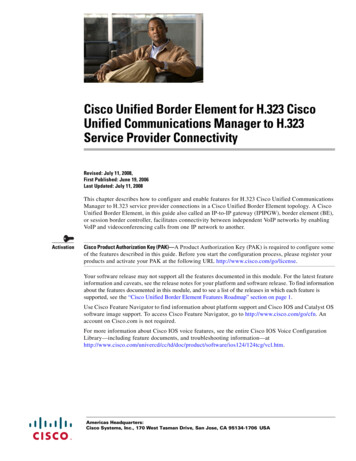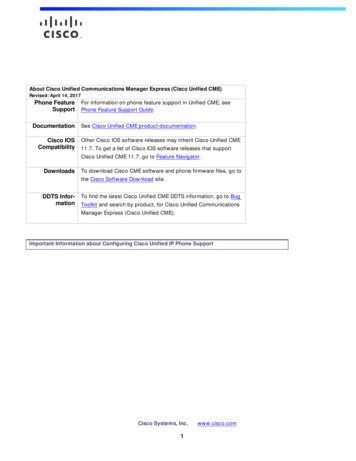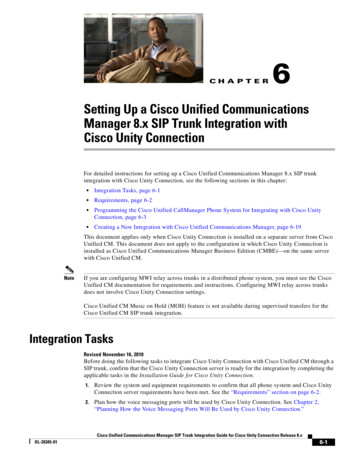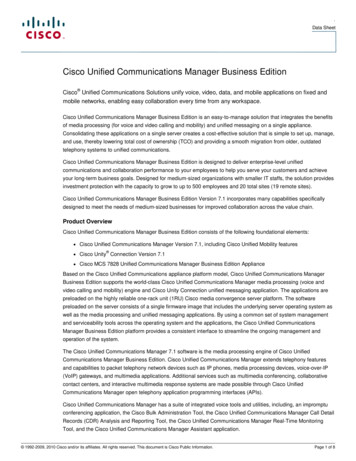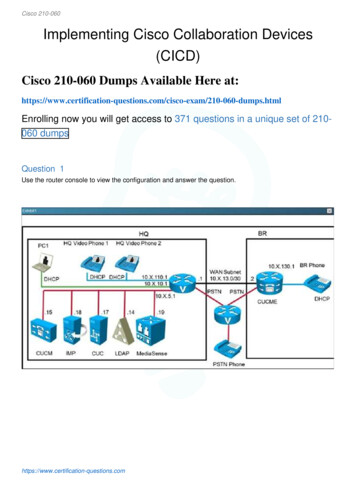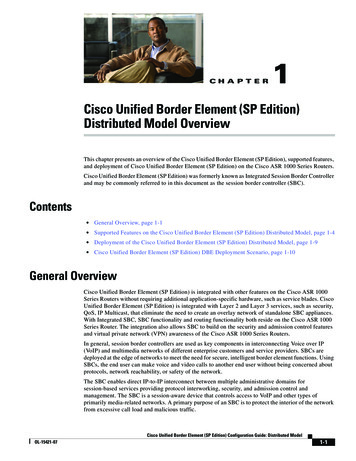
Transcription
CH A P T E R1Cisco Unified Border Element (SP Edition)Distributed Model OverviewThis chapter presents an overview of the Cisco Unified Border Element (SP Edition), supported features,and deployment of Cisco Unified Border Element (SP Edition) on the Cisco ASR 1000 Series Routers.Cisco Unified Border Element (SP Edition) was formerly known as Integrated Session Border Controllerand may be commonly referred to in this document as the session border controller (SBC).Contents General Overview, page 1-1 Supported Features on the Cisco Unified Border Element (SP Edition) Distributed Model, page 1-4 Deployment of the Cisco Unified Border Element (SP Edition) Distributed Model, page 1-9 Cisco Unified Border Element (SP Edition) DBE Deployment Scenario, page 1-10General OverviewCisco Unified Border Element (SP Edition) is integrated with other features on the Cisco ASR 1000Series Routers without requiring additional application-specific hardware, such as service blades. CiscoUnified Border Element (SP Edition) is integrated with Layer 2 and Layer 3 services, such as security,QoS, IP Multicast, that eliminate the need to create an overlay network of standalone SBC appliances.With Integrated SBC, SBC functionality and routing functionality both reside on the Cisco ASR 1000Series Router. The integration also allows SBC to build on the security and admission control featuresand virtual private network (VPN) awareness of the Cisco ASR 1000 Series Routers.In general, session border controllers are used as key components in interconnecting Voice over IP(VoIP) and multimedia networks of different enterprise customers and service providers. SBCs aredeployed at the edge of networks to meet the need for secure, intelligent border element functions. UsingSBCs, the end user can make voice and video calls to another end user without being concerned aboutprotocols, network reachability, or safety of the network.The SBC enables direct IP-to-IP interconnect between multiple administrative domains forsession-based services providing protocol interworking, security, and admission control andmanagement. The SBC is a session-aware device that controls access to VoIP and other types ofprimarily media-related networks. A primary purpose of an SBC is to protect the interior of the networkfrom excessive call load and malicious traffic.Cisco Unified Border Element (SP Edition) Configuration Guide: Distributed ModelOL-15421-071-1
Chapter 1Cisco Unified Border Element (SP Edition) Distributed Model OverviewGeneral OverviewThe SBC functions break down into two logically distinct areas: The signaling border element (SBE) function. SBEs may support functions that includeinterworking between various signaling protocols such as H.323 and Session Initiation Protocol(SIP), call admission control, advanced routing policy management, network attack detection, orcall billing using RADIUS or DIAMETER. As part of the call admission control function, an SBEinforms the data border element (DBE) of the various quality of service (QoS) and Network Addressand Port Translation (NAPT) requirements for the call. An SBE typically controls one or moremedia gateways.An SBE may be known as a media gateway controller (MGC). The data border element (DBE) controls access of media packets to the network, providesdifferentiated services and quality of service (QoS) for different media streams, and prevents servicetheft. The DBE consists of a set of data path functions and responds to the requests made by the SBEto open pinholes, taking into account the specified Network Address Translation (NAT)/firewalltraversal and QoS requirements.The distributed model of the Cisco Unified Border Element (SP Edition) implements the DBE functionon the Cisco ASR 1000 Series Aggregation Services Routers. A table of DBE-supported features islisted in Table 1-1.Figure 1-1 shows an example of SBC high-level architecture; your SBC architecture may differ.Figure 1-1Example of SBC High-Level ArchitectureSignaling Border Element(SBE)H.323SIPPolicyAAACDRHAVPN controlH.248 interfaceRTPQoSPolicyData Border Element(DBE)HA280018NAPTDistributed and Unified ModelsThe SBC can operate in two modes or models—unified and distributed. In the unified model, both the SBE and DBE logical entities co-exist on the same network element. In the distributed model, the SBE and the DBE entities reside on different network elements.Logically, each of the SBE entities could control multiple DBE elements. The DBE is controlled byone SBE at any one time.Cisco Unified Border Element (SP Edition) Configuration Guide: Distributed Model1-2OL-15421-07
Chapter 1Cisco Unified Border Element (SP Edition) Distributed Model OverviewGeneral OverviewFigure 1-2 illustrates the Unified SBC model.Figure 1-2Unified SBC ModelDomain ADomain B271026SBE DBECisco Unified Border Element (SP Edition) can run under the distributed model and provide the DBEfunctionality.The distributed model offers advantages over the unified model: Scalable to a larger number of sessions. Operational advantages, because the SBE can be upgraded or serviced separately from the DBE. The distributed model aligns well with typical voice deployments where the SBE can be co-locatedwith part of the call agent. The many-to-many interface offers capability to load share and balance across networks. Operatorshave the flexibility to optimize on loading of the SBE or DBE.Figure 1-3 illustrates the Distributed SBC model.Figure 1-3Distributed SBC ModelSBCDomain ADomain B271027SBEDBEStandardH.248InterfaceCisco Unified Border Element (SP Edition) Configuration Guide: Distributed ModelOL-15421-071-3
Chapter 1 Cisco Unified Border Element (SP Edition) Distributed Model OverviewSupported Features on the Cisco Unified Border Element (SP Edition) Distributed ModelSupported Features on the Cisco Unified Border Element (SPEdition) Distributed ModelThe supported features roadmap lists the features documented in this guide and provides links to wherethey are documented. Any related configuration commands for a feature are listed and documented inCisco Unified Border Element (SP Edition) Command Reference: Distributed Model /reference/sbc book.htmlNoteTable 1-1 lists only the Cisco IOS XE software releases that introduced support for a given feature in agiven Cisco IOS XE software release train. Unless noted otherwise, subsequent releases of that CiscoIOS XE software release train also support that feature.Table 1-1 lists features and associated commands that are supported on the Cisco Unified BorderElement (SP Edition) DBE deployment on the Cisco ASR 1000 Series Routers.Table 1-1Supported Features on Cisco Unified Border Element (SP Edition) Distributed ModelRelated SBCCommandsChapter WhereDocumentedBilling and Call DetailRecordsNone.Chapter 12, “QualityMonitoring andStatistics Gathering”Cisco IOS XE Release 2.1DBE Signaling PinholeSupportNone.Chapter 6, “H.248Services—Signalingand Control”Cisco IOS XE Release 2.1DBE Status Notification None.Chapter 12, “QualityMonitoring andStatistics Gathering”Cisco IOS XE Release 2.1DSCP Marking and IPPrecedence MarkingChapter 5, “Quality ofService and BandwidthManagement”Cisco IOS XE Release 2.1DTMF Interworking on dtmf-durationthe Cisco UnifiedBorder Element (SPEdition) DistributedModelChapter 3, “DTMFInterworking on theCisco Unified BorderElement (SP Edition)Distributed Model”Cisco IOS XE Release 2.1Enabling the OptionalH.248 PackagespackageChapter 7, “H.248Packages—Signalingand Control”Cisco IOS XE Release 2.1Enhanced EventNotification andAuditingh248-association-timeoutChapter 12, “QualityMonitoring andStatistics Gathering”ReleaseFeature NameCisco IOS XE Release 2.1None.h248-event-storageh248-preserve-gatesCisco Unified Border Element (SP Edition) Configuration Guide: Distributed Model1-4OL-15421-07
Chapter 1Table 1-1Cisco Unified Border Element (SP Edition) Distributed Model OverviewSupported Features on the Cisco Unified Border Element (SP Edition) Distributed ModelSupported Features on Cisco Unified Border Element (SP Edition) Distributed Model (continued)Related SBCCommandsChapter WhereDocumentedExtension to H.248Audit SupportNone.Chapter 6, “H.248Services—Signalingand Control”Cisco IOS XE Release 2.1Extension to H.248TerminationWildcarding SupportNone.Chapter 6, “H.248Services—Signalingand Control”Cisco IOS XE Release 2.1Firewall (Media Pinhole None.Control)Chapter 9, “Security inCisco Unified BorderElement (SP Edition)Distributed Model”Cisco IOS XE Release 2.1Flexible Address Prefix None.ProvisioningChapter 6, “H.248Services—Signalingand Control”Cisco IOS XE Release 2.1H.248 AddressReporting PackageChapter 9, “Security inCisco Unified BorderElement (SP Edition)Distributed Model”Cisco IOS XE Release 2.1H.248 Gate Information None.(Ginfo) PackageBecomes OptionalCisco IOS XE Release 2.1H.248 Network Package h248-media-alert-ev Chapter 12, “QualityMonitoring andQuality Alert Event and entStatistics Gathering”Middlebox PinholeTimer Expired EventCisco IOS XE Release 2.1H.248 SegmentationPackage SupportReleaseFeature NameCisco IOS XE Release 2.1None.package segmentmax-pdu-sizepackage segmentseg-timer-valueChapter 7, “H.248Packages—Signalingand Control”Chapter 7, “H.248Packages—Signalingand Control”show sbc dbecontrollersCisco IOS XE Release 2.1H.248 Session FailureReaction PackageNone.Chapter 7, “H.248Packages—Signalingand Control”Cisco IOS XE Release 2.1H.248 TerminationState Control Packageshow sbc dbemedia-flow-statsChapter 7, “H.248Packages—Signalingand Control”show sbc dbesignaling-flow-statsCisco IOS XE Release 2.1H.248 TrafficManagement PackageSupportNone.Chapter 5, “Quality ofService and BandwidthManagement”Cisco Unified Border Element (SP Edition) Configuration Guide: Distributed ModelOL-15421-071-5
Chapter 1 Cisco Unified Border Element (SP Edition) Distributed Model OverviewSupported Features on the Cisco Unified Border Element (SP Edition) Distributed ModelTable 1-1Supported Features on Cisco Unified Border Element (SP Edition) Distributed Model (continued)Related SBCCommandsChapter WhereDocumentedSyntax-Level Supportfor H.248 VLANPackageshow sbc dbemedia-flow-statsChapter 7, “H.248Packages—Signalingand Control”Cisco IOS XE Release 2.1H.248.1v3 Supporth248-versionChapter 7, “H.248Packages—Signalingand Control”Cisco IOS XE Release 2.1Cisco Unified BorderElement (SP Edition)High AvailabilityNone.Chapter 11,“High-AvailabilitySupport,”Cisco IOS XE Release 2.1Interim AuthenticationHeader Supporttransport (seeinterim-auth-header keyword)Superseded by InterimAuthentication HeaderFull SupportCisco IOS XE Release 2.1IP NAPT TraversalPackage and Latch andRelatch Supporth248-napt-packageChapter 9, “Security inCisco Unified BorderElement (SP Edition)Distributed Model”Cisco IOS XE Release 2.1IPv4 Support for TwiceNAPTNone.Chapter 13, “TopologyHiding”Cisco IOS XE Release 2.1IPv6 Inter SubscriberBlockingNone.Chapter 13, “TopologyHiding”Cisco IOS XE Release 2.1IPv6 Supportipv6 address(session bordercontroller)Chapter 13, “TopologyHiding”ReleaseFeature NameCisco IOS XE Release 2.1show sbc dbesignaling-flow-statsmedia-address ipv6media-address poolipv6port-range (ipv6)debug sbc filter (seeipv6 keyword)show sbc dbemedia-flow-stats(see ipv6 keyword)show sbc dbesignaling-flow-stats(see ipv6 keyword)Cisco IOS XE Release 2.1Local Source Properties None.(Address and Port)Chapter 9, “Security inCisco Unified BorderElement (SP Edition)Distributed Model”Cisco Unified Border Element (SP Edition) Configuration Guide: Distributed Model1-6OL-15421-07
Chapter 1Table 1-1Cisco Unified Border Element (SP Edition) Distributed Model OverviewSupported Features on the Cisco Unified Border Element (SP Edition) Distributed ModelSupported Features on Cisco Unified Border Element (SP Edition) Distributed Model (continued)Related SBCCommandsChapter WhereDocumentedLocally HairpinnedSessionsNone.Chapter 6, “H.248Services—Signalingand Control”Logging Level featurein Configuring theH.248 Logging Levellogging levellogging filtercontrol protocolChapter 2,“Configuring the CiscoUnified BorderElement (SP Edition)Distributed Model”Media Address Poolsmedia-address poolipv4Chapter 4, “MediaAddress Pools”ReleaseFeature NameCisco IOS XE Release 2.1Cisco IOS XE Release 2.1Cisco IOS XE Release 2.1media-address poolipv6port-rangeCisco IOS XE Release r 7, “H.248Packages—Signalingand Control”Cisco IOS XE Release 2.1MGC-Specified LocalAddresses or PortsNone.Chapter 6, “H.248Services—Signalingand Control”Cisco IOS XE Release 2.1MultiStreamTerminationsNone.Chapter 6, “H.248Services—Signalingand Control”Cisco IOS XE Release 2.1NAPT and NATTraversalNone.Chapter 9, “Security inCisco Unified BorderElement (SP Edition)Distributed Model”Cisco IOS XE Release 2.1Nine-Tier TerminationName HierarchyNone.Chapter 6, “H.248Services—Signalingand Control”Cisco IOS XE Release 2.1Optional Local andRemote DescriptorsNone.Chapter 6, “H.248Services—Signalingand Control”Cisco IOS XE Release 2.1Provisioned InactivityTimerh248-inactivity-durationChapter 12, “QualityMonitoring andStatistics Gathering”Cisco IOS XE Release 2.1QoS BandwidthAllocationNone.Chapter 5, “Quality ofService and BandwidthManagement”Cisco IOS XE Release 2.1Remote Source Address media-address ipv4Mask Filteringmedia-address poolipv4Chapter 9, “Security inCisco Unified BorderElement (SP Edition)Distributed Model”Cisco Unified Border Element (SP Edition) Configuration Guide: Distributed ModelOL-15421-071-7
Chapter 1 Cisco Unified Border Element (SP Edition) Distributed Model OverviewSupported Features on the Cisco Unified Border Element (SP Edition) Distributed ModelTable 1-1Supported Features on Cisco Unified Border Element (SP Edition) Distributed Model (continued)ReleaseFeature NameRelated SBCCommandsChapter WhereDocumentedCisco IOS XE Release 2.1RTCP PolicingNone.Chapter 5, “Quality ofService and BandwidthManagement”Cisco IOS XE Release 2.1RTP-Specific BehaviorSupportNone.Chapter 6, “H.248Services—Signalingand Control”Cisco IOS XE Release 2.1ServiceChangesbc interface-idNotification fortermination-idInterface Status ChangerootidnameChapter 6, “H.248Services—Signalingand Control”Cisco IOS XE Release 2.1T-MAX Timertmax-timerChapter 6, “H.248Services—Signalingand Control”Cisco IOS XE Release 2.1tsc-Delay TimerNone.Chapter 6, “H.248Services—Signalingand Control”Cisco IOS XE Release ding Cisco Unified BorderElement (SP Edition)Command Reference:Distributed and/reference/sbcbook.html)Cisco IOS XE Release 2.1Two-Rate Three-ColorPolicing and er 5, “Quality ofService and BandwidthManagement”show sbc dbeforwarder-statsCisco IOS XE Release 2.2Full Support forWildcard ResponseNone.Cisco IOS XE Release 2.2None.H.248Protocol—Acknowledgment Support forThree-Way HandshakeChapter 7, “H.248Packages—Signalingand Control”Cisco IOS XE Release 2.2H.248 ServiceChangeHandoffChapter 6, “H.248Services—Signalingand Control”Cisco IOS XE Release 2.2Full Support for Interim transportAuthentication HeaderinboundNone.outboundChapter 6, “H.248Services—Signalingand Control”Chapter 9, “Security inCisco Unified BorderElement (SP Edition)Distributed Model”Cisco Unified Border Element (SP Edition) Configuration Guide: Distributed Model1-8OL-15421-07
Chapter 1Table 1-1Cisco Unified Border Element (SP Edition) Distributed Model OverviewDeployment of the Cisco Unified Border Element (SP Edition) Distributed ModelSupported Features on Cisco Unified Border Element (SP Edition) Distributed Model (continued)Related SBCCommandsChapter WhereDocumentedImproved MediaTimeout Detectionmedia-timeoutChapter 12, “QualityMonitoring andStatistics Gathering,”IPsec PinholeSupport—Twice NATfor IPv4 and No NATfor IPv6media-address ipv4Chapter 6, “H.248Services—Signalingand Control”ReleaseFeature NameCisco IOS XE Release 2.2Cisco IOS XE Release 2.2media-address poolipv4media-address ipv6media-address poolipv6Cisco IOS XE Release 2.3In-Service Provisioning None.of H.248 ControllersCisco IOS XE Release 2.3RTCP maximum burstsize policing parameterfeature in RTCPPolicingNone.Chapter 5, “Quality ofService and BandwidthManagement”Cisco IOS XE Release 2.6Optional TmanBandwidth ParameterPolicingbandwidth-policetmanQuality of Service andBandwidthManagementCisco IOS XE Release 2.6Return Local andRemote Descriptors inH.248 ingand ControlCisco IOS XE Release 2.6SBC d Controltmax baserootChapter 6, “H.248Timers”Cisco IOS XE Release 2.6.2 H.248 TimersCisco IOS XE Release 3.1S ETSI Ia Profile on SBC h248-profilebandwidth-fieldsmandatoryChapter 6, “H.248Services—Signalingand Control”Chapter 8, “ETSI IaProfile on SBC”Deployment of the Cisco Unified Border Element (SP Edition)Distributed ModelDeployment of the DBE function on the Cisco ASR 1000 Series Routers integrates a subset of the CiscoUnified Border Element (SP Edition) feature set with Cisco IOS XE software. A likely deploymentscenario is that typical routing and broadband features are configured on the Cisco ASR 1000 SeriesCisco Unified Border Element (SP Edition) Configuration Guide: Distributed ModelOL-15421-071-9
Chapter 1Cisco Unified Border Element (SP Edition) Distributed Model OverviewCisco Unified Border Element (SP Edition) DBE Deployment ScenarioRouters serving as the DBE operating with an external SBE. The Cisco Unified Border Element (SPEdition) functionality on the Cisco ASR 1000 Series Routers comprises both DBE and SBE functions,with DBE being the first to be deployed.DBE deployment of the Cisco Unified Border Element (SP Edition) feature set is an optional featuresupported on the Cisco ASR 1000 Series Routers. DBE deployment on the Cisco ASR 1000 SeriesRouters does not include SBE support and no SBE-related CLIs are implemented.In the deployed distributed model, the SBE and the DBE entities reside on different network elementsand the DBE is controlled by one SBE at any one time. The SBE interacts with the DBE using the H.248Megaco (media gateway controller) protocol. The SBE controls the DBE via the H.248 interface. In thismodel, the bearer (or media flow) always flows through the DBE, and the SBE participates only in thesignaling flow.The DBE is responsible for the media flows and consists of a set of data path functions. The DBEresponds to the requests made by the SBE to open pinholes, taking into account the specifiedNAT/firewall traversal and QoS requirements.For the DBE, a new interface type is defined for the SBC virtual interface. You configure a virtualinterface as part of the SBC configuration and the virtual interface has media IPs as primary or secondaryIP addresses. The SBC virtual interface does not support any existing Cisco IOS features.The Cisco IOS XE image containing Cisco Unified Border Element (SP Edition) software leveragesexisting Cisco IOS install and packaging facilities for software release, delivery, and installation.Cisco IOS commands have been introduced to configure the DBE. For information on commands, seeCisco Unified Border Element (SP Edition) Command Reference: Distributed Model /reference/sbc book.htmlCisco Unified Border Element (SP Edition) DBE DeploymentScenarioOne potential deployment scenario for the distributed model of Cisco Unified Border Element (SPEdition) is in a network architecture where the service provider (SP) provides voice, data, and videoservices to their residential broadband customers over a single link.This scenario requires the SP to provide capabilities such as opening pinholes for the duration of aconversation, and doing this without exposing the devices behind the firewall to malicious threats. Inaddition, given that voice is extremely sensitive to issues such as delay, latency, and packet loss, ensuringadequate performance is a challenge. QoS mechanisms can be implemented to ensure proper priority isassigned to voice packets.In this deployment scenario, multiple applications share a common link. Thus a mechanism that willlimit bandwidth available to individual applications to ensure appropriate end-to-end quality is needed.For voice, this would involve correctly marking the packet to ensure appropriate priority, as well ascontrolling the number of simultaneous calls at the network entry point. Because the SP cannot dictatewhat IP phones their customers use, protocol conversion functionality is needed—especiallyH.323-to-SIP conversion.Service providers require measurement of traffic for reporting and billing purposes in this potentialscenario. Some carriers may also want to offer service level agreement (SLA) for voice, for which theywant to be able to provide their customers with the proof that these SLAs are being met.Cisco Unified Border Element (SP Edition) Configuration Guide: Distributed Model1-10OL-15421-07
Chapter 1Cisco Unified Border Element (SP Edition) Distributed Model OverviewCisco Unified Border Element (SP Edition) DBE Deployment ScenarioFigure 1-4 illustrates a deployment where Integrated SBC is used for VoIP interworking.Figure 1-4Integrated SBC Used for VoIP InterworkingSBCSP3PSTNSBCSBCSBCSP1IP/MPLS workMMMMIPIPIPIPIP271025IPMManaged EnterpriseUnmanaged EnterpriseResidential BroadbandCisco Unified Border Element (SP Edition) Configuration Guide: Distributed ModelOL-15421-071-11
Chapter 1Cisco Unified Border Element (SP Edition) Distributed Model OverviewCisco Unified Border Element (SP Edition) DBE Deployment ScenarioCisco Unified Border Element (SP Edition) Configuration Guide: Distributed Model1-12OL-15421-07
and deployment of Cisco Unified Border Element (SP Edition) on the Cisco ASR 1000 Series Routers. Cisco Unified Border Element (SP Edition) was formerly known as Integrated Session Border Controller and may be commonly referred to in this document as the session border controller (SBC). Contents General Overview, page 1-1


